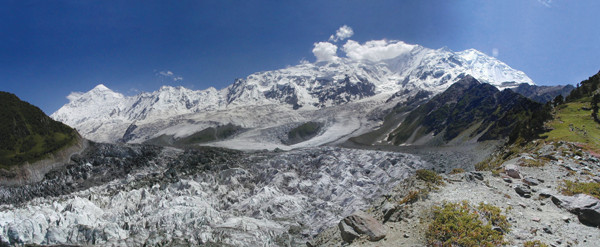
by Timothy Oleson Monday, July 9, 2012

Two prominent peaks — Diran (left) and Rakaposhi — tower over a glacier in the Karakoram Range of northern Pakistan to the west of an area where, a new study suggests, glacial ice volume has remained stable or perhaps grown slightly in recent years. Copyright Waqas.usman, Creative Commons Attribution-ShareAlike 3.0 Unported
When it comes to glaciers, stability represents a refreshing change of pace. In contrast to regional and global trends — which, scientists say, have unambiguously indicated ice loss in recent decades — a team of French glaciologists has confirmed that glaciers in a portion of the northwestern Himalayas remained stable on average, or may have even grown slightly, in recent years. The results have implications for local water supplies and glacial hazards and, the team says, underscore the value of high-resolution monitoring in accurately determining regional-scale glacial changes.
Using spaceborne data to study a 5,615-square-kilometer section of the Karakoram Range of northern Pakistan and western China, the researchers found an increase in ice thickness of 0.11 (plus or minus 0.22) meters of water equivalent (w.e.) per year between 1999 and 2008. Although small in magnitude, the value is significant because it diverges from best estimates of glacial ice volume change globally and over the entire Himalayan mountain range, which suggest a loss of about 0.4 to 0.8 meters w.e. per year, the team reported in Nature Geoscience.
Given the uncertainty in the measurement, “it’s not 100 percent sure” that there was really a mass gain, says Tobias Bolch, a glaciologist at the University of Zurich in Switzerland. But, says Bolch, who was not involved in the study but was lead author of a recent review article on the current state of Himalayan glaciers published in Science, “what is clear is there is no significant mass loss.”
Additionally, the results “show that we need to be careful as glaciologists when we are extrapolating measurements made on a few small glaciers,” says Etienne Berthier, a glaciologist at the Université de Toulouse in France and a co-author of the Nature Geoscience study. Estimating the past and future behavior of glaciers for which there is no direct evidence available — as well as their impact on sea-level change — based on observations of other glaciers is a necessity, to some extent, he says. But such extrapolations must be done carefully “because not all glacial regions are changing in the same way.”
The study’s results imply that the Karakoram glaciers might have lowered global sea levels over the period studied, albeit by only 0.006 millimeters per year. But previous estimates — assuming the Karakoram glaciers had behaved like others in the Himalayas that had been better characterized — suggested that their expected ice loss would have raised sea level by roughly 10 times as much.
Over the years, there have been other indications of anomalous behavior among Karakoram glaciers, which account for about 3 percent of the total glacial ice-covered area in the world, excluding Greenland and Antarctica. Many had experienced surges — relatively sudden increases in ice flow rate — that transferred large amounts of ice downslope and extended glacial termini to lower elevations. Increased snow cover along with decreased summer temperatures and runoff to nearby rivers was also reported in preceding decades. But these were all indirect or empirical indicators of glacial growth. Direct measurements had not been attempted, largely because the region is so vast and remote. That is why a geodetic survey was particularly useful in helping piece together a more complete picture, Berthier says.
The team used radar measurements taken from the space shuttle Endeavour in early 2000 along with data from a 2008 satellite survey to create separate pixelated digital elevation models of the study area. Looking at the difference between the two models, the researchers identified where the ice had thickened or thinned and by how much. They found significant heterogeneity, with particular glaciers thickening or thinning by as much as 16 meters per year on average. They also found that detrital debris-covered and debris-free glaciers showed similar behavior, contradicting the conventional wisdom that such debris cover — when more than several centimeters thick — insulates underlying ice and slows melting.
Bolch says he is confident in the results and that the study highlights the need for more detailed investigation. “We really need more precise measurements so that we can say what is going on and what the causes of this somehow irregular behavior of the Karakoram glaciers are,” he says.
Berthier says he and his colleagues next plan to take a closer look at regional climate models and meteorological data “to better understand the origin of this anomaly.” They also hope to expand their geodetic surveying to the rest of the Himalayas, which, he says, would provide a “comprehensive and consistent dataset to really look at the difference between glaciers.”
© 2008-2021. All rights reserved. Any copying, redistribution or retransmission of any of the contents of this service without the expressed written permission of the American Geosciences Institute is expressly prohibited. Click here for all copyright requests.